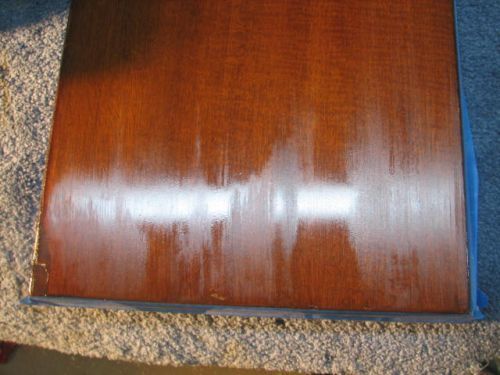Wrinkling of a Shellac Re-Finish
Pros advise on what could have caused the trouble in an application of shellac to an already finished wood bench. July 28, 2008
Question
I repaired this old piano bench for a client - loose legs, split bottom, etc. The top had a very hazy look right where you would normally sit. I thought I would just do a quick refinish so I could return the bench with the high gloss restored. The plan was one or two good coats of shellac, and then to rub it out to a high gloss. I sanded the top, going through the grits to 320, tack clothed the whole thing, and got what you see in the picture. At first I thought maybe I'd slow the dry time by adding some denatured alcohol which would help it to flow out. That only seemed to make the wrinkling even more pronounced. My only thought was maybe the owners had waxed the top and my sanding did not get rid of it? Should I have wiped it down with something before applying the shellac? Any other thoughts on why the shellac would wrinkle, not orange peel, but wrinkle like a raisin?

Click here for full size image
Forum Responses
(Finishing Forum)
From contributor A:
I've seen it a lot - how old is the finish approximately?
From the original questioner:
The shellac is only about 4 months old. It's Zinsser Bulls Eye clear. It's probably obvious, but I should add that it was brushed, not sprayed.
From contributor A:
Probably your first coat was not thoroughly dry, and the second coat lifted or reacted with the first coat causing it to wrinkle. Let the whole thing dry for 3 or 4 days, then sand 320 and recoat. If it's cold wait longer. Get back to us with results.
From contributor B:
When restoring a piece like you've done here, it's good to wipe it down before you start doing any sanding. This way you're not sanding any contaminants into the finish. This picture looks to me as if you might have sanded through a layer or two of the existing finish and when you applied the new finish it was trying to play catch up. It's kind of a small piece - can you clean it up to the raw wood and start over with a new finish?
From the original questioner:
I thought about taking it down to raw wood. However, it's a mahogany veneer and it definitely was stained originally. I'd rather not get into restaining to match the rest of the bench. I was just looking to gloss up the top before returning the piece. Any reason why my cutting the shellac with denatured alcohol would cause it to wrinkle much worse than straight shellac? What is the best thing to wipe the top down with? Alcohol dissolves the existing shellac. Should I use mineral spirits or naphtha?
From contributor A:
Naphtha's a better cleaner, but MS will suffice. Anytime you're recoating you should wipe the surface off several times to remove any possible contaminant - wax, silicone polish, etc. Also keep in mind that because the shellac was purchased 4 months ago that it may have set on the shelf for many more months or longer. Check the packaging date on the can and it will tell you how old it really is. To avoid this scenario in the future learn the friction polishing method and wrinkling will never happen with French polishing. Also buy shellac flakes and make up fresh shellac for use.
From contributor B:
Usually packaged shellac is ready to apply right out of the can. Adding more alcohol to it just might have made it too "hot" for the original coating.
From contributor C:
I have seen this too. It happens when I try brushing on a heavy coat. Shellac needs to be vigorously brushed out in thin coats if you're going to brush it. I have not had this problem when applied by padding. Zinsser is usually a 3 lb cut and needs to be thinned. For brushing I like a 2 lb cut and for padding a 1 - 1.5 lb cut. Denatured alcohol is the correct thinner and I'm sure did not cause this problem. I use 200 prf but as long as it doesn't contain too much water you should be OK. Too much water will extend the drying time and cause shellac to precipitate out.
A fresh coat of shellac will always bite into the existing coat - you can't make it "too hot". Alcohol will fix any problem you can encounter with shellac. Using enough of it will remove the finish (you don't have to sand it off). Using a little on a pad you can manipulate then smooth, polish or re-amalgamate an existing finish. It is also used straight to "spirit off" a French polished surface.
On this piece I would have:
1. Cleaned with a mild Dawn/water solution.
2. Cleaned again with naphtha.
3. Padded on a couple coats of 1 lb cut shellac.
As it is I would wipe it down very well with alcohol to get rid of the wrinkles. Then pad on 4 or 5 coats of 1 lb cut.
